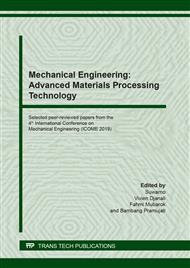p.32
p.41
p.48
p.54
p.62
p.68
p.75
p.82
p.91
Effect of Copper Addition on Fatigue Strength Al-10Si Alloys Produced by Die Casting
Abstract:
Aluminum Silicon Alloy (Al-Si) is widely used in the industry because it has a good cast ability, good mechanical properties and good corrosion resistance. At its expense, many failures are caused by fatigue fracture. Fatigue fracture is caused by a dynamic load within a certain time or cycle. Nearly 90% of structural components damaged caused by fatigue fracture. To improve the mechanical properties of Al-Si alloys can be added Cu elements. In this study Al-10Si alloys added Cu elements with variations of 1, 3, 5 (wt.%) Through die casting process. The casting results are mechanical characterized by hardness test, tensile test and fatigue test. The microstructure was examined by optical microscope and SEM. The results showed that the addition of Cu elements up to 5 wt. % in Al-10Si increased hardness to 98 HRB and tensile strength to 245.23 MPa but decreased ductility from 3.1% to 2.4%. The results of fatigue test showed a significant increase in the number of cycles at 80MPa can reach 1.5 x 107 without fracture (fatigue endurance limit). The microstructure examination results confirmed the presence of CuAl2. The CuAl2 phase inhibits dislocation movement so that greater force for deformation and improve mechanical properties
Info:
Periodical:
Pages:
62-67
Citation:
Online since:
October 2020
Authors:
Keywords:
Price:
Сopyright:
© 2020 Trans Tech Publications Ltd. All Rights Reserved
Share:
Citation:


